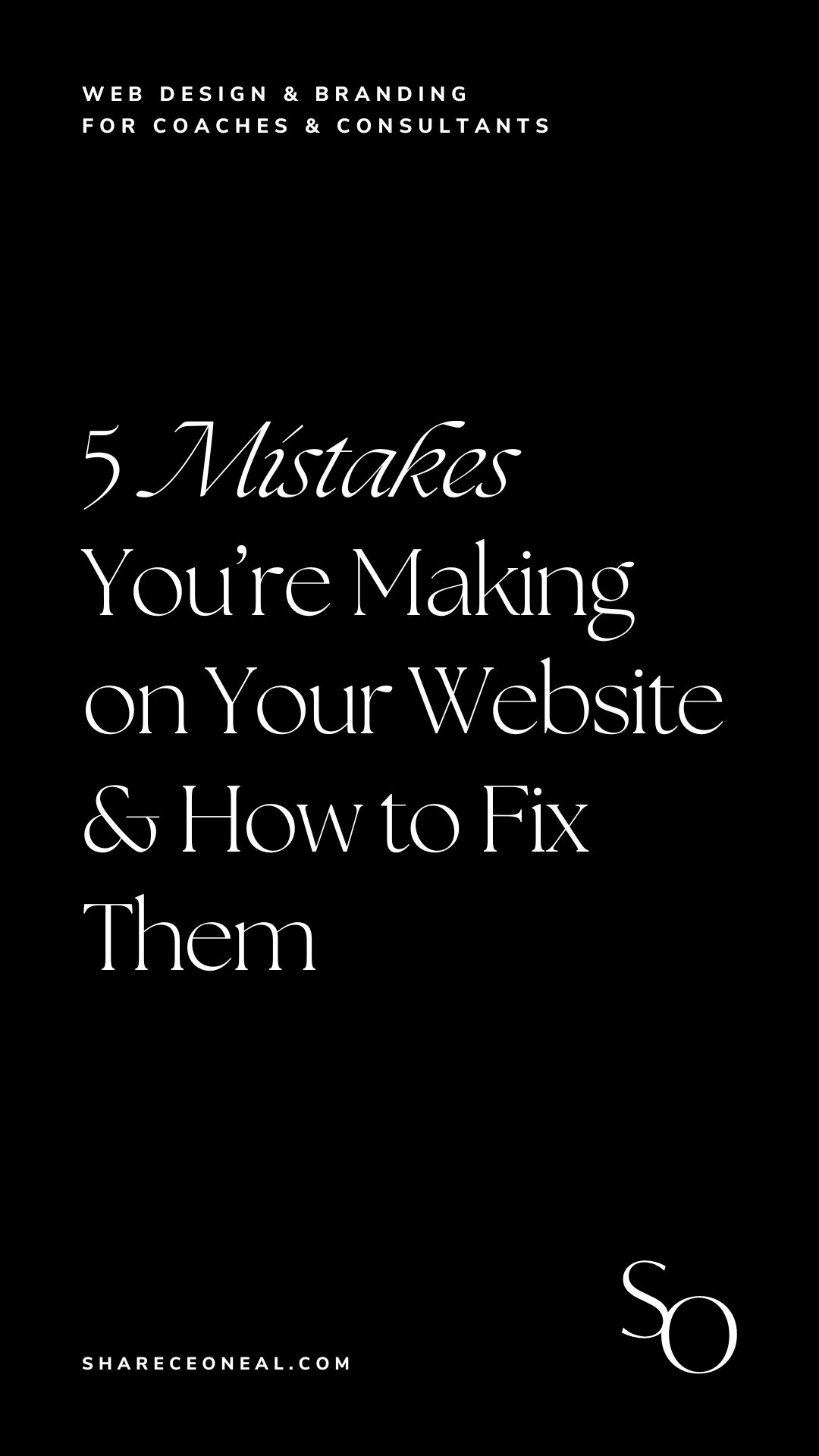5 Mistakes You’re Making on Your Website and How to Fix Them
Imagine it's December, and you're reviewing your accomplishments from the past year.
You look specifically at your website's performance, and to your amazement, you crushed your goals!
You doubled your email subscribers, tripled your consultation calls, booked out your speaking calendar, and increased organic website traffic by 175%.
That means you increased conversions, booked more clients, and ultimately, increased your bottom line.
Hands down, you just had the best year yet!
How does that feel? Amazing, right?
Well, this can be your reality... but only if you've designed and optimized your website for conversions and connection with your ideal clients.
Your website has the potential to be a powerful tool in your brand's arsenal, but there may be areas where you’re losing connections and conversions without even knowing.
I've gathered the top 5 website mistakes I see many coaches and consultants making that keep you from making more sales, repel potential clients, and undermine your reputation and expertise.
1. You Don't Have Clear Website Navigation
Let me ask you this, have you ever been to a restaurant with no menu?
And it doesn’t have to be a fancy restaurant. Have you ever been to a fast food drive-thru and they didn't have a menu as you pulled up?
Maybe some of us know specific restaurant menus like the back of our hand (ahem, Chick-Fil-A!), but that's not always the case.
Whether ordering the Market Salad, a small waffle fries, and a medium sweet tea/lemonade mix or selecting the right coaching and consulting package to move your business forward, we all expect to have a clear path to navigate toward our end goals.
Your audience expects the same thing from your website.
By having a clear website navigation bar, you’re steering your audience quickly and seamlessly through the various pages of your site.
If your website visitors can’t find the information they’re looking for effortlessly, they’ll likely leave your website. Your navigation has to be concise and easy to use.
Website navigation gone wrong.
You may think, "Okay, I know what a navigation bar is and how it works."
But let me tell you, there’s a wrong and right way to create a navigation bar and menu.
Doing it wrong could cost you. Such a simple element on your website could make or break your user experience. Here are a few ways it could damage your reputation and send your audience running for the door.
POOR USER EXPERIENCE: Without clear navigation, it can be difficult for users to find the content they’re looking for, leading to a poor user experience. A good navigation bar typically includes your logo, a list of pages clearly labeled, categories, a search bar, or other interactive elements such as a shopping cart or account login. Good website navigation bars are intuitive and make it easy for users to find what they are looking for quickly.
LOW CONVERSION RATES: If users can’t find what they are looking for, they may leave your website without taking action. Do you really want your website visitors frustrated if they can’t find specific pages or are unsure of the next steps? Unclear navigation could lead to decreased conversion rates, and you could miss out on potential sales.
REDUCED SEARCH ENGINE RANKINGS. Search engines place preference on sites that have organized with organized navigation structures. A straightforward navigation menu makes it easier for search engine crawlers to index your website and understand what information is available on each page. This can help improve your website's visibility in search engine results. It also helps your rankings to have your menu labeled with easy-to-understand titles such as home, about, and services. I hate to say it, but this is not the time or place to get fancy.
It’s safe to say that this seemingly small part of a website can wreak havoc on your user experience. Consider using a simple navigation bar with drop-down menus or tabs to make it easier for visitors to find the content they need. You can also consider adding breadcrumbs or drop-downs to help users easily trace their paths on your website.
Adding simple and intuitive navigation to your website is an important step to help your visitors find what they’re looking for quickly and easily.
And that’s what we want! We want their experience to be as painless and as smooth as possible because a great experience can lead to more engagement with your website and help to build trust in you.
2. You’re Not Telling a Story Through Your Website
Do you feel like your business isn't being seen or heard?
Is engagement low, and your audience isn't responding as you want them to?
Do you feel like your message isn't landing the way it should?
The heart of the issue is your brand story and messaging.
Websites are all about conveying information in an engaging and memorable way. And what better way to do that than by telling a story?
Think of some of your favorite brands.
Let’s take Nike, for instance. Nike is all about the athlete. Athletes give blood, sweat, and tears striving and painstakingly working towards their goals – to be the absolute best at what they do. Every Nike commercial, ad, or piece of content is devoted to serving athletes and telling their stories.
It’s proven that our brains connect with stories. A good story allows us to see ourselves as the main or supporting characters. We connect with their journey and cheer for the hero along the way.
Your website is your opportunity to use storytelling to connect with your audience. This is so important that I wrote a 3-part series on creating a brand story and how to use it to connect with your audience in these articles:
What is a Brand Story? And 3 Reasons Why Your Coaching and Consulting Business Needs One
How to Develop Your Authentic and Compelling Brand Story
8 Ways to Use Your Authentic Brand Story to Connect with Your Ideal Clients
Storytelling can create an emotional connection with your audience and build customer loyalty. You can also use stories to highlight the unique aspects of your products and services and explain their value.
With the proper storytelling techniques, you can create a powerful and memorable experience for your website visitors, where you become the perfect guide to lead them to success.
The biggest pitfall of not telling your brand story
Unfortunately, I see many coaches, consultants, and entrepreneurs not taking advantage of the art of storytelling to engage with their audience.
The biggest pitfall of not having a brand story is that your brand becomes generic and bland in the eyes of your audience.
How devastating would it be for all of your hard work, knowledge, and expertise to be overshadowed by a bland website with no story?
Here are a few ways not having a brand story could hurt your reputation and conversions.
AN UNENGAGED AUDIENCE. By not telling a story through your website, you miss out on engaging with your audience and creating an emotional connection with them. Stories your clients relate to your brand and understand why you do what you do.
YOU BLEND IN WITH THE CROWD. Without a brand story, you become like everyone else in your industry. Storytelling on your website helps differentiate you from competitors and makes your brand stand out. By creating a narrative, you can highlight what makes you unique and the benefits of working with you.
A FORGETTABLE BRAND EXPERIENCE. A good story creates a memorable experience for your audience and encourages them to return for more. By weaving a narrative around your website, you can make it more enjoyable and memorable for your visitors.
Crafting a compelling brand story is the key to differentiating your business from others in a competitive market and creating an authentic connection with your audience.
Simon Sinek said it best in his book, Start with Why:
"People don't buy what you do; they buy why you do it."
People want to know why you do what you do and how you can serve them. Let’s get started on crafting your unique brand story. Check out this article to get started: How to Develop Your Authentic and Compelling Brand Story
3. You Don’t Have a Clear Call to Action
I’ve been on plenty of beautiful websites, only to be left frustrated and confused.
I’ll find myself amazed by the content and images but reach the end of the homepage thinking, “Well, l how do I buy this thing? How do I sign up? What do I do next?”
Have you been there?
It’s an awkward and uncomfortable place to be.
We’re all busy, so having to take the time to send an email or search for contact information can leave a sour taste.
I believe that a great website has a seamless experience. It’s easy and intuitive.
So, how do we guide our website visitors to the next steps we want them to take?
By having a clear call to action!
A call to action is a prompt that encourages visitors to take a specific and strategic action. This could be signing up for a newsletter, downloading a free resource, or purchasing your product.
It’s essential to provide clear, concise directions on your website so that visitors know exactly how to take the desired action.
Time to be bold and direct with your call to action.
Not having a clear call to action can do more harm than the awkward silence of not knowing where to click next. Here are three ways it can actually impact your brand:
FRUSTRATED WEBSITE VISITORS = MISSED CONVERSIONS. There’s nothing worse than guiding your visitors through who you are and what you do but having them leave without taking action. Without a clear and direct call to action, your potential clients won't know what to do next, leaving them frustrated and confused. They may not return to work with you or could tell their network about their less-than-stellar experience with your brand.
MISS OUT ON TRACKING WEBSITE PERFORMANCE. Tracking your website’s performance and effectiveness is much more difficult without a call to action. A call to action allows you to measure how many people are taking the desired action, giving you valuable insight into how your website performs. This data can show you what your audience is drawn to and how you can serve them better.
TARNISH YOUR BRAND IMAGE. Not having a call to action on your website can hurt your overall brand image. A call to action is an excellent indicator of a confident, professional, and organized website, which can help give visitors a positive impression of your business.
So now you know the importance of having a clear call to action, let’s look at how we create one.
A good CTA is more than adding a “Buy Now” button. It’s the grand finale of the user experience.
As we saw in the last mistake, your website and brand’s story is how we engage the audience, and the call to action is how we invite them to begin their journey of working with you.
I recommend having one main call to action at the end of each page just before the footer. Make sure it’s prominently displayed, with plenty of white space, so visitors can easily see what they need to do.
A clear button labeled with their next step, such as “Sign up for our newsletter” or “Book a Consultation,” can help guide your visitors to take the desired action. Additionally, adding a description of the call to action can help make it clearer to your visitors.
This is not a time to be shy!
Ask for the sale! Invite them in! Be direct about the next step they should take!
Go for it! Your potential clients need the unique skills and gifts only you can offer.
4. You’re Website Isn’t Optimized For Mobile Devices
According to Google, 50% of web traffic comes from mobile devices.
That’s a staggering number!
The way we interact with websites is shifting. More and more people are using smartphones and tablets to access websites, and if your site isn’t optimized for mobile use, you may miss out on clients.
Ultimately, optimizing your website for mobile means making sure it looks and functions properly on devices with smaller screens. This often means building a mobile view responsive to various device types.
Web design with mobile in mind
If you neglect this detail and don’t consider the mobile view, it could hurt your website visitors' experience. Here are a few ways this could also impact your brand.
REDUCED AUDIENCE REACH: As more people use their mobile devices to access the internet, having a website optimized for various devices will help you reach a larger audience and increase your visibility. If not, this could make users frustrated and abandon your website, resulting in fewer conversions and sales.
LOWER SEARCH ENGINE RANKINGS: Many search engines, such as Google, now use mobile-friendliness as a ranking factor. Not having a responsive site could drop you down in search engine rankings, meaning less organic traffic.
OUTDATED DESIGN: If your website isn't mobile-friendly, it could appear outdated, untrustworthy, and unappealing to potential visitors. This could lead to visitors forming a negative opinion of your website and cause them to lose confidence in your brand.
Luckily, website platforms such as Squarespace have a built-in, mobile-ready responsiveness that makes it easy for you or your designer to create a unique, scalable design.
As you optimize your mobile view, here are a few pro tips to keep in mind to make sure your audience has a seamless experience::
LEVERAGE MOBILE-FRIENDLY TECHNOLOGIES. If you’ve created a blog on your Squarespace site, consider using Accelerated Mobile Pages (AMP) technology to make your blog easier to navigate and load quickly on mobile devices.
MAKE SURE ALL KEY ELEMENTS ARE VISIBLE. Make sure that all elements of your web page are visible on mobile devices and that they don't require a lot of pinching and zooming. Additionally, it's important to ensure that website features, such as buttons and links, are easy to view and click.
MAKE SURE YOUR CONTENT IS CONCISE. Mobile users tend to scan instead of read, so make sure your content is concise and to the point.
Mobile optimization is non-negotiable and the reality of today’s technology. By optimizing your website for mobile, you can ensure it works well for all users regardless of the device they're using.
Keeping the mobile view at the top of your mind will keep your brand seamless and consistent across the board. This means increased credibility, connections, and conversions among your ideal clients - all indicators of a successful brand.
5. You’re Not Optimizing Your Website for Search Engines
Google has become a verb – a staple in our everyday vocabulary.
Searching for something? “Google it!”
We’ve all been there and said it.
So, what does that mean for you as a business owner?
Over the last several years, “Google has invested significantly in enhancing the user experience by providing increasingly accurate and relevant search results,” according to Brightedge Research. They found that “consumers trust Google and rely on it even more and are using it at a rate that exceeds the growth of display and organic social.”
This means that organic search is still a key source of website traffic!
Optimizing your website for search engines increases your website's visibility in organic search engine results. If you want your site to be easily found by people searching for your services or products, you’ll have to be intentional and strategic about your website's SEO (search engine optimization).
And if you’re not taking advantage of organic search, you could miss out on a significant source of website traffic. Here’s what that could mean for your website and your brand:
LOW VISIBILITY: Optimizing your website for search engines can help you increase visibility and organic traffic. If your website isn’t optimized for search engines, it won't appear in search engine results, meaning fewer people will be able to discover you.
DECREASED ORGANIC TRAFFIC: Poor visibility can lead to low website traffic, impeding your brand's ability to reach potential clients and build its online presence. Using SEO best practices can ensure that more people see your website.
FEWER CONVERSIONS: Low visibility and decreased organic traffic mean fewer people see and interact with your website or purchase your products or services.
A solid SEO strategy requires research, focus, and intention to see results quickly.
The good news for Squarespace users is that Squarespace has built-in SEO functionality, which makes optimizing your site easy and accessible.
For a complete list of strategies for optimizing your site for search, check out my blog post on Squarespace SEO Best Practices for Coaches and Consultants.
I’ve also created a quick checklist to guide you through implementing each step of your Squarespace SEO. Download it here: Squarespace SEO Checklist for Coaches & Consultants.
Optimizing your website for search engines can increase traffic, visibility, and overall performance.
Ready for a Website That Checks All the Boxes?
Creating a strategic, optimized website that is compelling and irresistible is an investment in your brand and business, but the rewards are well worth it. When you create a seamless experience for your audience, you’ll build that “know, like, and trust” factor, turning them into raving fans who want to experience all you offer.
You got this!
















